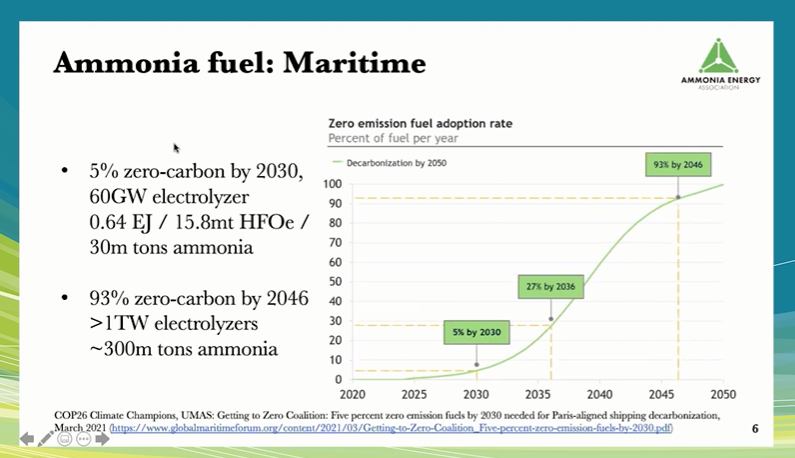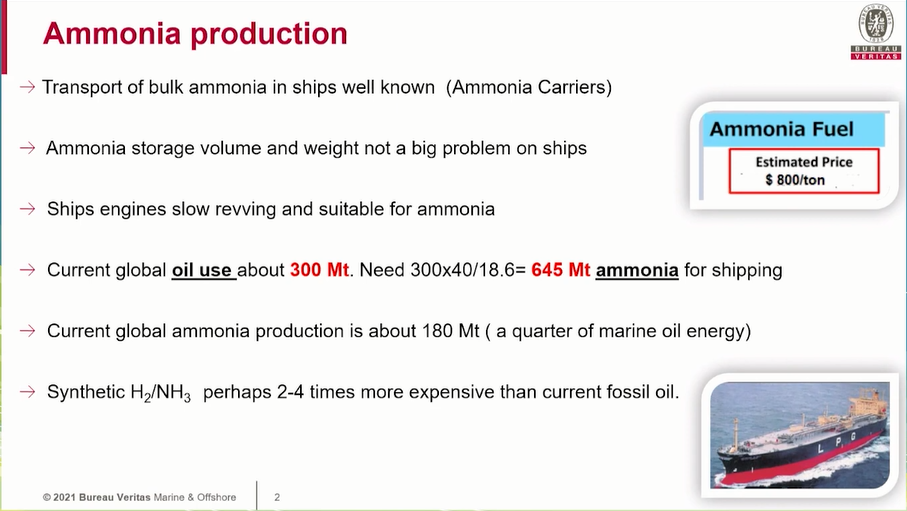Although there are many advantages from using ammonia as a marine fuel, there are also many challenges around which need to be controlled by technical and regulatory measures in order ammonia to become a feasible solution for a carbon-free shipping economy. In light of the situation, during the 2021 GREEN4SEA Virtual Forum, speakers of Panel 10, focused on the potential of ammonia as a fuel and its latest developments.
To begin with, Trevor Brown, Executive Director, Ammonia Energy Association along with Dr. John Kokarakis, Vice President Technology & Business Development Hellenic-BS-ME Zone, Bureau Veritas, Dr. Michail Cheliotis, Research Associate, Maritime Safety Research Centre, University of Strathclyde and Jan Flores, Vice President, NETSCo, Inc., were all shared their perspective on ammonia, which is considered as one of the best alternative fuels of the future.
Ammonia seems to be a promising carbon free energy carrier with high energy density and already available infrastructure distribution with respect to other carbon free solutions.
…said Mr. Brown.
According to Mr. Brown, currently, ammonia production accounts for a significant share of about 1% of global CO2 emissions.

As discussed, a pathway to market is to understand the role ammonia has within the energy transition. Based on the above infographic, by 2030, zero carbon fuels are expected to hit a 5% fuel mix. That means that the industry has 9 years to build 60GW of electrolyzers in order to produce approximately 30m tons of ammonia.
What is more, Mr. Jan Flores presented the business case for ammonia vs other alternative fuels, highlighting the following points:
- LNG: We can learn from the development of LNG as a fuel source. However, LNG GHG emissions are still an issue.
- Methanol: Do offer many advantages, but is not carbon free. At the same time, green methanol does offer some promise.
- Hydrogen: Carbon free, but storage is very complex.
- Ammonia: While it is a currently traded commodity (fertilizer)- infrastructure is in place- the technology to use ammonia as a fuel is still under development.
- The rules for transporting ammonia are already in place.
- Increasing progress in developing a “green” ammonia from renewable sources.
- Ammonia as Hydrogen storage is very promising.

Why burn ammonia for power?
Mr. Kokarakis marked that ammonia has the potential to substitute pure hydrogen for storage, while is easily to liquefy and transport. At the same time, it is non-flammable and non-explosive but highly toxic and corrosive. As further explained, anhydrous ammonia may cause stress corrosion cracking in carbon-manganese steel or nickel steel.
Key points for ammonia
- Mature production – Target: Green ammonia
- Higher volumetric energy density than hydrogen
- Lower fire risk- higher ignition temperature (>900°C)
- Can be used in diesel engines, gas turbines, fuel cells
- It requires a pilot fuel for combustion
- Need to abate NOx emissions
- Green ammonia could drive investment in renewable energy
80% of ammonia produced today is utilized in the fertilizer industry, therefore its production must increase in order to serve as a fuel for shipping.
… Mr. Kokarakis stated.
Following the discussion, Mr. Michail Cheliotis shared that ammonia can be part of the complex solution for achieving the IMO 2050 decarbonization goal. Mr. Cheliotis shed light on the safety aspects around ammonia as a fuel, marking that:
Flammability: No jet fires, narrow explosion limit window (15-28%), low chance of pool fire, potential classification of hazardous zones.
Toxicity: NH3 can fatal at concentrations above 40’000ppm, gas dispersion studies through CFD, release scenarios, ventilation arrangements, verification through experimental studies (FLADIS), hazardous zones.
Safety: Hazard identification and functional model-based system reaction examination, fault injection and response simulation (Fuzzy Cognitive Maps), critical components identification, online fault-detection modules.
We need to see not only how ammonia is a decarbonization solution in the short term, but also how it fits within the shipping industry in the long term. In fact, we need to take into account the shipping trends and see how ammonia can actually serve them.
.. as Mr. Cheliotis said.
Overall, speakers agreed that although ammonia is an attractive solution as a marine fuel, there are still some concerns around its availability, infrastructure, storage and regulations.
Explore Panel 10 of 2021 GREEN4SEA Virtual Forum herebelow:































































